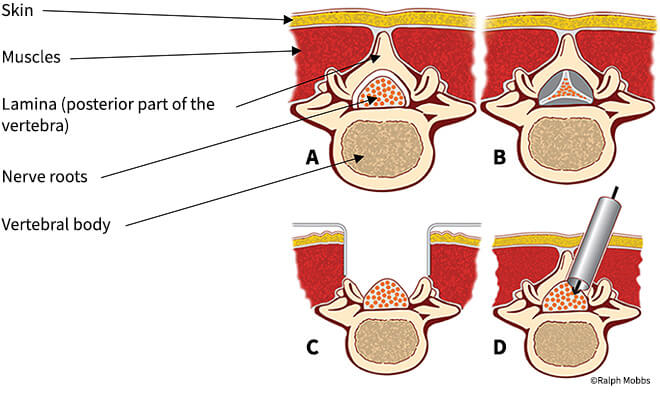Minimally invasive spine surgery (MISS) has been developed within the last 20 years in an effort to treat pathologies of the spine, causing only minimal tissue trauma. In general, each minimally invasive spinal procedure originates from a traditional – “open” procedure with well-established efficacy.
Minimally Invasive Alternatives
The aim of a MISS procedure is to achieve the same anatomical result as its open equivalent, with much less tissue trauma, and accordingly fewer tissue trauma-related complications. There are minimally invasive alternatives for most of the spinal surgery techniques: herniated disc removal, vertebral osteosynthesis for unstable fractures, spinal fusion, narrow canal decompression, even for complex surgery as scoliosis correction.
Technical Aspects of MISS
From a technical point of view, the aimed result of minimal trauma is achieved by the use of a tubular retractor in a way that pushes away muscle fibres instead of cutting them, for the surgical instruments to pass through. The use of a surgical microscope is imperative. Endoscopic spinal surgery is a variation of decompressive MISS, which uses an endoscope instead of the microscope and can be performed by even less traumatic “paths”.
Indications and Advantages of MISS
Besides the fact that there are minimally invasive equivalents for practically every spinal pathology that needs surgery, the indications may vary and often the use of traditional techniques is preferred, as being more relevant and expected to be more efficient for a specific patient’s pathology. The main advantage of MISS is less post-operative pain and more rapid recovery.
Disadvantages of MISS
Every MISS technique that has been established in clinical practice has been proven to offer at least an equivalent clinical result comparing to its open alternative. In many cases, minimally invasive techniques have been proven to be superior to their alternatives concerning post-operative pain, hospitalization duration, blood loss during surgery and infection rates. However, the main disadvantage of MISS is its relatively higher cost, related to the need for special equipment (microscope/endoscope and adapted instruments, which are often unique for each technique).
Conclusion
Despite the disadvantages, MISS is still considered cost-effective in most cases, as a result of the lower complication rate, shorter hospitalization, and faster recovery. Another disadvantage is the relatively long surgeon’s learning curve, which still prevents MISS from being available to patients in many cases. Each patient should trust a spinal specialist to decide mainly if a surgical treatment is an appropriate option for their problem. The choice of method follows, with MISS being relatively advantageous when performed by an experienced surgeon and when there is no specific reason to choose an open technique.
Written by Triantafyllos Bouras




